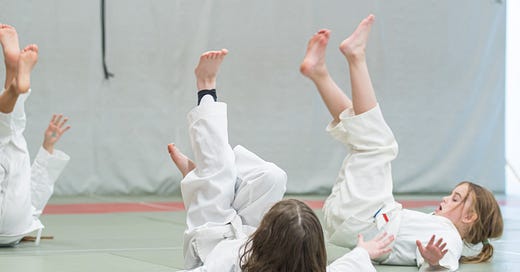We’re excited to share an article by Cheryl Whitelaw (1st dan), an Aikidoka and Feldenkrais practitioner from Canada. You can learn more about Cheryl at the end of the article. For now, enjoy this practical guide to learning—and teaching—Aikido rolls without dizziness!
Learning to roll in Aikido was a dizzying experience for me. Once I was taught the basics of how to roll, the primary training technique was to repeat rolls as often as possible, rolling forwards and backward along the length of the dojo mat.
In my first year of training, in every class, I became dizzy and disoriented. Slowly my dizziness receded.
For many newcomers to Aikido, the experience of dizziness while learning to roll ends their training. I was reassured that it would go away and to just keep rolling.
When I started my Feldenkrais practitioner training, a learning method that uses movement to improve how our brain and nervous system generate movement, I had an opportunity to learn from Moti Nativ, a Feldenkrais practitioner and Judo teacher. His teaching helped me to appreciate how slow movement exploration with awareness could refine the quality of movement, in particular, when learning how to roll.
Why Do We Get Dizzy When We Start Learning to Roll?
Our sense of where we are located in space is created moment by moment by a flow of information from 3 systems:
Our vision - about 80% of our sense of balance comes through vision
Our vestibular system - we have 3 semi-circular canals located near our inner ears that tell our brain where our head is located in space.
Our proprioceptive system - it tells us where our body is in space by detecting and controlling force and pressure
When something disrupts the flow of this information, like rolling forwards or backward, your central nervous system can process information incorrectly so you feel unsteady and dizzy. We can feel dizzy because of inner ear disorders, neurological conditions, and some medications. But it is possible to feel dizzy without suffering from a health condition. It is our balance system that needs to be conditioned for a rolling movement.
What to Do About It?
I have spent the last 5 years exploring how to relieve the experience of dizziness for newcomers to our club, drawing from the application of Feldenkrais lessons to the challenge of learning how to roll. There is no one-size-fits-all solution; each person’s sense of balance is conditioned by their personal history. Here are some of the training approaches I have found helpful for people to reduce dizziness and develop a sense of balance while rolling.
1. Eyes on the horizon: Keep your eyes on your personal horizon before and after rolling. Looking down at the ground during a roll can disturb your vestibular system; we are designed to find balance when our eyes look forward. Looking down at the ground also accentuates the trajectory of the head moving down towards the ground and can increase a sense of dizziness.
2. Feel the ground: Develop a sensory relationship with the ground, sensing pressure and weight as limbs and torso make contact with the ground. For example, the “Teddy bear” rolls with attention to the way pressure and body weight dynamically move through the body helps to develop greater proprioceptive sensory input. I find that for many people, their sense of balance relies strongly on their eyes and, to a lesser extent, on their proprioceptive capacity. Strengthening their sensory perception can decrease dizziness and improve their balance.
3. Eyes lead the movement: Use of gaze to give a clearer sense of direction of movement. In front rolls, I ask beginners to kneel and slide their front hand under their opposite knee, watching their hand as it reaches toward their back foot. When that is comfortable, I ask them to follow their hand until they roll over. In back rolls, I ask them to look at their toe and to follow it over their shoulder with their gaze. When that is comfortable and they can touch their toe to the ground, I cue them to bend their knee and go over. Vision is our strongest contributor to balance so using it through the roll can leverage this flow of information to the brain and reduce dizziness.
4. Breathe: I remind beginners to breathe out as they start to roll. Holding their breath and tensing the muscles near their diaphragm is a stress response and can increase their sense of dizziness. Holding tension during rolling, including around the diaphragm, impacts blood and oxygen flow through the body and contributes to dizziness.
5. Pause when needed: Use a movement snacking approach to rolling; short amounts of rolling, followed by pauses. To support beginners to condition their 3-part balance system, they need pauses to let those systems process the sensory information. I support beginners to choose their own pace for rolling and pausing and to decide when they have had enough for the day. I have found that with repeated short rolling periods and pauses people can start to reduce their experience of dizziness.
6. Take your time: When stepping up the level of challenge, like front rolls from seiza to rolling from a standing leg and knee, if beginners experience disorientation, dizziness or a reflexive bracing that can look like holding their breath and arching their back or neck, I encourage them to return to an earlier stage of rolling. In this training approach, we are looking to build positive brain-body neurological connections. Before these connections are reliably built, repeating movements that lead to dizziness and reflexive bracing reinforce subtle fear responses, taking us away from our goal of dizzy-free rolling.
7. Feel your center: Once beginners have more comfort in basic rolling, I cue them to pay attention to the trajectory of their pelvis through space. Beginners tend to locate themselves in their heads. Putting their attention to their pelvis helps them connect with their actual center of gravity as they change their orientation to the field of gravity.
We Can Learn to Move Past Dizziness
Developing dizzy-free rolling takes time and patience. During the pandemic, when local lockdown rules prevented us from training inside, we shifted our training outdoors and rolled less. When I started rolling in the dojo again, some of the dizziness returned. I committed to applying these Feldenkrais-based principles to my rolling until I stopped feeling dizzy. I found that my rolling became even smoother than before the pandemic. I also find now that I can detect sooner when I am losing my balance as uke. I am enjoying my refined sense of balance and feel more responsive and fluid as uke. For me, re-visiting the process of rolling and bringing awareness to the movement skills needed in rolling has been a worthwhile study.
Did you experience dizziness when you started Aikido? What helped you to go on? And if you’re a teacher, how do you teach ukemi to students who experience dizziness when rolling?
Related articles
Read more articles from the cycle Movement Development in Aikido
About the Author
Cheryl Whitelaw is a 1st dan black belt who volunteers in teaching children and adult Aikido classes at Abundant Peace Internal Martial Arts School, led by Brad Schultz Sensei in Edmonton, Canada.
Cheryl is a certified Feldenkrais practitioner, an Integral Master Coach™ and a Being in Movement Practitioner™, a method that combines Aikido and Feldenkrais to support people to regain their resourcefulness after experiencing trauma.
She is a functional movement specialist, supporting people to reclaim balance, mobility and power after life changing injuries and illnesses. She also works with aging athletes, particularly martial artists, to improve their performance at any age.
Her aikido practice focuses on the refinement of relationships with the environment, within her body and between mind and body to cultivate internal coherence, calm and power.
Cheryl also trains Tai Chi and Nei Gong.







Wow! Thank you for this terrific article and wonderfully articulated teaching guidelines. Having recently finished leading a month-long "aikido for beginners" class series, I was reminded that ukemi is indeed the biggest hurdle that beginners must overcome to begin to really have fun and feel at ease on the mat.
I wonder if you have any insights you can share on how to get people to what I would call the "next phase" of ukemi skills -- namely being able to take ukemi spontaneously in the flow of a dynamic interaction, without the need to "set up" (i.e. think).
Thank you again for this very helpful and timely article. I will share it with the teachers at my dojo!
This is a really interesting and helpful note. Thank you. I teach white belts basic ukemi and kihon dosa to prep them to join the main class